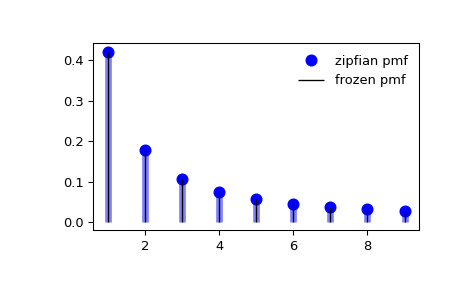scipy.stats.zipfian#
- scipy.stats.zipfian = <scipy.stats._discrete_distns.zipfian_gen object>[source]#
A Zipfian discrete random variable.
As an instance of the
rv_discreteclass,zipfianobject inherits from it a collection of generic methods (see below for the full list), and completes them with details specific for this particular distribution.Methods
rvs(a, n, loc=0, size=1, random_state=None)
Random variates.
pmf(k, a, n, loc=0)
Probability mass function.
logpmf(k, a, n, loc=0)
Log of the probability mass function.
cdf(k, a, n, loc=0)
Cumulative distribution function.
logcdf(k, a, n, loc=0)
Log of the cumulative distribution function.
sf(k, a, n, loc=0)
Survival function (also defined as
1 - cdf, but sf is sometimes more accurate).logsf(k, a, n, loc=0)
Log of the survival function.
ppf(q, a, n, loc=0)
Percent point function (inverse of
cdf— percentiles).isf(q, a, n, loc=0)
Inverse survival function (inverse of
sf).stats(a, n, loc=0, moments=’mv’)
Mean(‘m’), variance(‘v’), skew(‘s’), and/or kurtosis(‘k’).
entropy(a, n, loc=0)
(Differential) entropy of the RV.
expect(func, args=(a, n), loc=0, lb=None, ub=None, conditional=False)
Expected value of a function (of one argument) with respect to the distribution.
median(a, n, loc=0)
Median of the distribution.
mean(a, n, loc=0)
Mean of the distribution.
var(a, n, loc=0)
Variance of the distribution.
std(a, n, loc=0)
Standard deviation of the distribution.
interval(confidence, a, n, loc=0)
Confidence interval with equal areas around the median.
See also
Notes
The probability mass function for
zipfianis:\[f(k, a, n) = \frac{1}{H_{n,a} k^a}\]for \(k \in \{1, 2, \dots, n-1, n\}\), \(a \ge 0\), \(n \in \{1, 2, 3, \dots\}\).
zipfiantakes \(a\) and \(n\) as shape parameters. \(H_{n,a}\) is the \(n\)th generalized harmonic number of order \(a\).The SciPy implementation of this distribution requires \(1 \le n \le 2^{53}\). For larger values of \(n\), the
zipfianmethods (pmf, cdf, mean, etc.) will return nan.When \(a > 1\), the Zipfian distribution reduces to the Zipf (zeta) distribution as \(n \rightarrow \infty\).
The probability mass function above is defined in the “standardized” form. To shift distribution use the
locparameter. Specifically,zipfian.pmf(k, a, n, loc)is identically equivalent tozipfian.pmf(k - loc, a, n).References
[1]“Zipf’s Law”, Wikipedia, https://en.wikipedia.org/wiki/Zipf’s_law
[2]Larry Leemis, “Zipf Distribution”, Univariate Distribution Relationships. http://www.math.wm.edu/~leemis/chart/UDR/PDFs/Zipf.pdf
Examples
>>> import numpy as np >>> from scipy.stats import zipfian >>> import matplotlib.pyplot as plt >>> fig, ax = plt.subplots(1, 1)
Get the support:
>>> a, n = 1.25, 10 >>> lb, ub = zipfian.support(a, n)
Calculate the first four moments:
>>> mean, var, skew, kurt = zipfian.stats(a, n, moments='mvsk')
Display the probability mass function (
pmf):>>> x = np.arange(zipfian.ppf(0.01, a, n), ... zipfian.ppf(0.99, a, n)) >>> ax.plot(x, zipfian.pmf(x, a, n), 'bo', ms=8, label='zipfian pmf') >>> ax.vlines(x, 0, zipfian.pmf(x, a, n), colors='b', lw=5, alpha=0.5)
Alternatively, the distribution object can be called (as a function) to fix the shape and location. This returns a “frozen” RV object holding the given parameters fixed.
Freeze the distribution and display the frozen
pmf:>>> rv = zipfian(a, n) >>> ax.vlines(x, 0, rv.pmf(x), colors='k', linestyles='-', lw=1, ... label='frozen pmf') >>> ax.legend(loc='best', frameon=False) >>> plt.show()

Check accuracy of
cdfandppf:>>> prob = zipfian.cdf(x, a, n) >>> np.allclose(x, zipfian.ppf(prob, a, n)) True
Generate random numbers:
>>> r = zipfian.rvs(a, n, size=1000)
Confirm that
zipfianreduces tozipffor large n,a > 1.>>> import numpy as np >>> from scipy.stats import zipf, zipfian >>> k = np.arange(11) >>> np.allclose(zipfian.pmf(k, a=3.5, n=10000000), zipf.pmf(k, a=3.5)) True